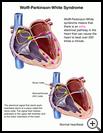
Wolff-Parkinson-White Syndrome
________________________________________________________________________
KEY POINTS
- Wolff-Parkinson-White (WPW) syndrome means that there is an extra electrical pathway in the heart that can cause a very fast heartbeat.
- Treatment depends on how often your child has symptoms and the severity of the symptoms. Treatment may include medicine, cardioversion, or ablation.
- Follow your child's healthcare provider's instructions. Ask your child's provider what symptoms or problems you should watch for and what to do if your child has them.
________________________________________________________________________
What is Wolff-Parkinson-White syndrome?
Wolff-Parkinson-White (WPW) syndrome means that there is an extra electrical pathway in the heart that can cause a very fast heartbeat. An electrical signal in your heart starts each heartbeat, causing the heart muscle to squeeze (contract). Normally, this signal starts in the upper right chamber of the heart (the right atrium) at a place called the sinus node. The signal then follows pathways to the upper left atrium and to the lower chambers of the heart (the ventricles).
In WPW, the extra electrical pathway can cause the heart to beat over 200 times a minute. This may happen only a few times in a person's life, or it may happen as often as once or twice a week.
WPW may cause symptoms as early as the first year of life or not until you are an adult.
What is the cause?
People with WPW are born with an extra electrical pathway. Usually a person with WPW does not have other heart problems, but some people may have other heart defects. Heart defects may be inherited, which means that they can be passed from parents to children through their genes. Genes are inside each cell of your body. They contain the information that tells your body how to develop and work.
What are the symptoms?
Your child may have no symptoms. If your child’s heart starts beating very fast, it may cause:
- A thumping, pounding, or racing feeling in the chest or neck
- Lightheadedness or dizziness
- Weakness
- Shortness of breath
- Sweating
- Chest pain
- Fainting
How is it diagnosed?
Your child’s healthcare provider will ask about your child’s symptoms and medical history and examine your child. Tests may include:
- ECG (also called an EKG or electrocardiogram), which measures and records your child’s heartbeat. Your child may be asked to wear a small portable ECG monitor for a few days or longer.
- Electrophysiologic study (EPS), which uses tiny wires put into your child’s heart through the veins to look at the electrical pathways in the heart
- Echocardiogram, which uses sound waves (ultrasound) to show the structures of the heart and how well the heart is pumping
- Angiogram, which is a series of X-rays taken after your healthcare provider injects contrast dye into your child’s blood vessels to check the structure of the heart
- MRI, which uses a strong magnetic field and radio waves to show detailed pictures of the heart and blood vessels
How is it treated?
Your child’s treatment depends on how often your child has symptoms and the severity of the symptoms. Your child may not need treatment if:
- Your child rarely has a fast heartbeat
- It doesn’t last long
- It doesn’t cause serious symptoms
If your child needs treatment to help the heart keep a normal rhythm, possible treatments are:
- Medicine to control the heart rate
- Electrical cardioversion: First, your child will be given medicine called anesthesia to keep from feeling pain during the procedure. Then her chest will be given an electrical shock. The electrical shock should make your child’s heart start beating normally again. Your child may need medicine to keep the heart rhythm normal after this procedure.
- Ablation: Ablation is a procedure that uses a small tube called a catheter to deliver energy to the inside of the heart. The energy (usually radio waves) scars small areas of heart tissue. The scars block abnormal electrical pathways and help your child have a normal heart rhythm. With some types of ablation treatment, your child will also need a pacemaker. A pacemaker is an electronic device put under the skin of the chest to help control the heartbeat.
How can I take care of my child?
Follow your child’s healthcare provider's instructions. Ask your provider:
- How and when you will get your child’s test results
- How long it will take for your child to recover
- If there are activities your child should avoid and when your child can return to normal activities
- How to take care of your child at home
- What symptoms or problems you should watch for and what to do if your child has them
Make sure you know when your child should come back for a checkup. Keep all appointments for provider visits or tests.
Last modified: 2018-11-01
Last reviewed: 2018-10-29

